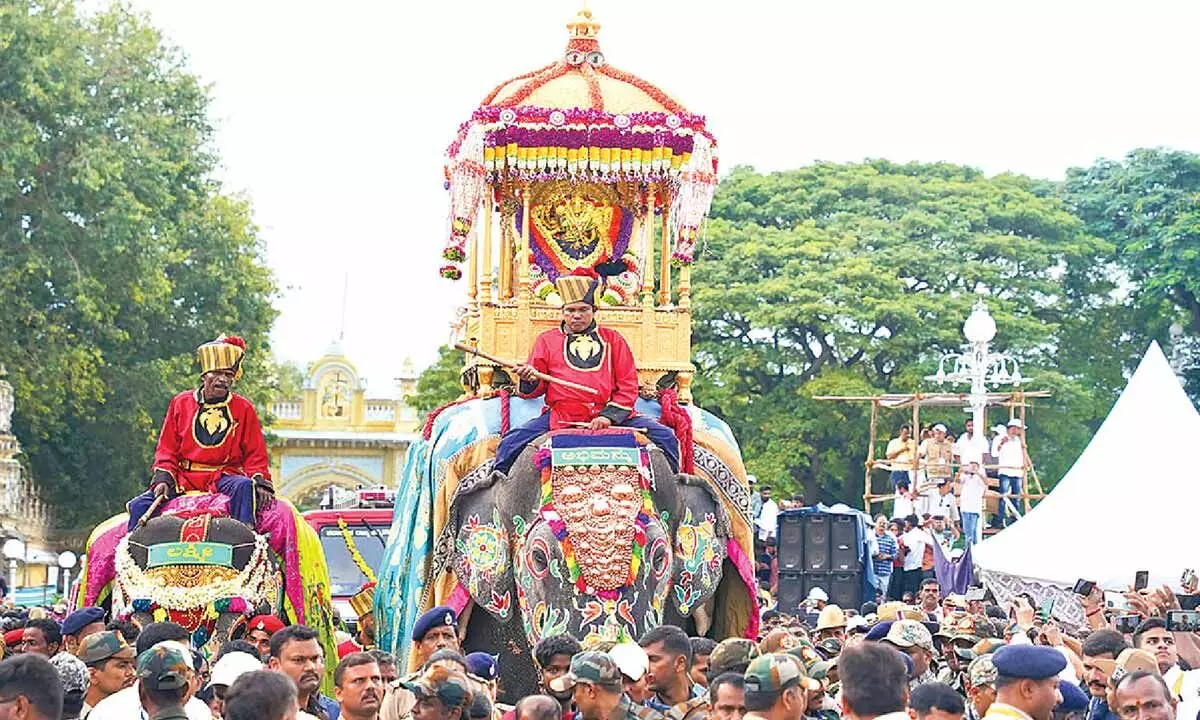Live
- WPL 2025: Matthews, Sciver-Brunt and Harmanpreet carry MI to massive 213/4
- MLA Anirudh Reddy Accuses KTR of Involvement in Manhattan Project Scam
- TGPSC Clarifies on False Propaganda Regarding Group-1 Recruitment
- Hyderabad Police Ensures Security as Holi and Ramadan's Second Friday Coincide
- Five MLCs Elected Unopposed in Telangana Under MLA Quota
- Sambhal prepares for a peaceful Holi with tightened security and special patrols
- CNG, PNG prices to become cheaper in Rajasthan from March 14
- Anti-Rape ad to screen in theaters before movies, like health advisories
- Prodigy Finance Offers Three Scholarship Awards totalling an amount of $19,000 for Global Students Starting Fall 2025
- Champions League drama likely to affect La Liga with big games this weekend
Tradition vs Compassion: The debate over elephants in religious and cultural events


The ‘fabled’ Dasara Jamboo Savari is over in Mysuru, 16 elephants have endured 45 days of torture in the city away from their natural evergreen abodes in the forests of K-Gudi, Hunsuru and Chamarajanagar.
Mangaluru: The ‘fabled’ Dasara Jamboo Savari is over in Mysuru, 16 elephants have endured 45 days of torture in the city away from their natural evergreen abodes in the forests of K-Gudi, Hunsuru and Chamarajanagar. Every day they walked on a flat tarmac from Amba Vilas palace to Banni Mantap a distance of 5.3 kilometres in the city twice to practice for ‘grand’ Jamboo savari featuring the golden houdah on Vijayadashami day. Throughout this period the elephants undergo tremendous stress and physical fatigue.
Elephants, long considered symbols of strength and wisdom in many cultures, hold a significant place in the religious and cultural events of South India. From Mysuru Dasara in Karnataka to temple festivals in Kerala and Tamil Nadu, these majestic creatures are showcased with grandeur, serving as a bridge between ancient traditions and present-day religious fervour. However, this practice is now under intense scrutiny as experts and animal rights activists call for an end to the use of elephants in such festivals.
A member of the Karnataka Elephant Task Force told Hans India on conditions of anonymity, “We do not know how the tradition of mounting a gold houdah weighing 750 kg on the elephant crept in and in what timeline. The murals in the Jaganmohan palace and old books of the history of royal Mysuru also talks about a ‘Aane Gaadi’ (elephant cart) that used to be drawn by the most powerful elephants in the royal stables.There was also a time when the Maharaja of the Mysuru Sansthan used to ride the elephant. But after 1956 the government of Karnataka had switched to carrying the Golden houdah with the ‘Utsav Murthy’ mounted on the elephant. The elephant is made to carry over 1300 kgs of weight. This was done without consulting veterinarians or any expert on elephant physiology. The elephant with a flat sole should not be made to walk on flat surface which gives not just pain but also structural damage and the vertebral column also undergoes damage due to heavy carriage of flat bottom houdah for long hours the experts opined.
Karnataka’s Elephant Task Force: Leading the Way in Reform
Karnataka is one of the few states that have acknowledged the dangers of using elephants in such events. In 2012, the state established its Elephant Task Force, which created comprehensive guidelines for managing both wild and captive elephants. The task force has since become a model for other states when addressing elephant-related issues, including human-elephant conflicts, translocation of problem elephants, and their use in religious and entertainment settings.
An experienced Mahout (elephant driver) and senior Kavadi (elephant attendant) felt that after every Jamboo Savari I have felt the stress and fatigue of the elephant that carry the houdah, Drona, Balarama and now Abhimanyu all have displayed exhaustion after the event. They are strong no doubt but they are strong in their own territory and environment not in human civilisation full of sounds and activities alien to them they said.
The stress and strain caused by these processions have led to multiple incidents of elephants going berserk, endangering the lives of both humans and other animals. The Toll on Human Lives and Elephants’ Well-Being
The use of elephants in temple festivals, despite its deep-rooted tradition, has come at a significant cost. In the last 14 years, over 350 people have lost their lives in southern India due to incidents involving captive elephants at temple festivals. These fatalities include mahouts, caretakers, and festival-goers. The elephants, under severe physical and psychological strain, often lash out, destroying property and killing people.
The Shift Toward Technology: Mechanical Elephants
In a groundbreaking move toward animal welfare, the Sri Siddalingeshwara Swamy Temple in Karnataka’s Tumkur district made history by introducing a mechanical elephant for its rituals and ceremonies. This initiative, supported by several animal rights organizations, including People for the Ethical Treatment of Animals (PETA) India, aims to protect elephants from the trauma of captivity while allowing devotees to maintain their traditions. The mechanical elephant can perform ceremonial duties without endangering human lives or compromising animal welfare.
Moreover, the Wildlife Protection Act classifies elephants as a “national heritage animal,” yet thousands remain in captivity. Kerala, Uttar Pradesh, Karnataka, Assam, Tripura, and Madhya Pradesh together account for 96% of captive elephants in India, many of which lack proper ownership certificates, indicating the potential for illegal wildlife trafficking.
Despite advancements in animal welfare, the use of live elephants in religious events continues to raise legal and ethical questions. The Prevention of Cruelty to Animals Act (1960) and the Wildlife Protection Act (1972) prohibit the capture and mistreatment of elephants, yet violations persist. For example, using Ankush weapons during temple processions is illegal under a 2010 ruling by the Rajasthan High Court, but photographic evidence from festivals like Mysuru Dasara shows that this ban is often ignored.

© 2025 Hyderabad Media House Limited/The Hans India. All rights reserved. Powered by hocalwire.com






